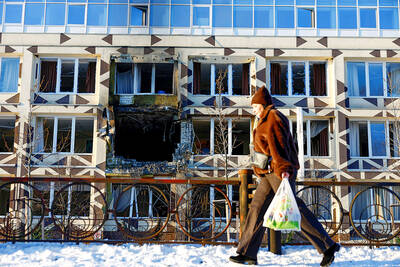Press photographs of prostitutes plying their trade right out on the street have reignited a debate about the practice in Spain, where it has seen rapid growth over the past 15 years.
Traditionally perceived as relatively marginal, prostitution is increasingly seen as “normal,” with ever younger men preferring to pay for sex rather than taking the trouble of trying to pick up girls.
Prostitution is again making headlines after the daily newspaper El Pais published pictures of prostitutes and their clients having sex on the street at night in a Barcelona tourist neighborhood.
Barcelona had become increasingly lax in applying a 2006 municipal ordinance that stipulated fines of up to 750 euros (US$1,050) for sex workers or their clients, critics complain. The ordinance was aimed at eradicating such practices from central districts.
Associations representing local residents or the prostitutes themselves urged a legalization of the trade, describing it as the only way to guarantee prostitutes adequate working conditions.
The city, however, only deployed more police to chase the sex workers off the streets in the Raval neighborhood.
The debate revealed a problem affecting, not just Barcelona, but all of Spain, where — like in many other European countries — the authorities have been unable to choose between a Swedish-style ban and a Dutch-style legalization of prostitution.
The practice has thus been left in legal limbo, which makes it more difficult for police to pursue criminals trafficking in prostitutes, leaving thousands of women at the mercy of pimps coercing them into the trade.
The influx of immigrants has led to the growth of prostitution in Spain, where up to 300,000 women are estimated to be selling sex in flats, hostels, streets, parks or at around 2,500 “clubs” functioning as brothels.
One of the world’s most lucrative criminal trades moves an estimated 18 billion euros in Spain annually.
Around 90 percent of the sex workers are migrants from countries such as Brazil, Colombia, Nigeria, Romania or Russia.
There is abundant judicial evidence that many of the women have been lured to Spain with false promises and forced into prostitution with threats, beatings, rape and even outright torture.
“Sexual exploitation rings are very cruel, the roughest I have seen in my career,” police officer Carlos Igual said.
However, prostitution is not technically illegal, and police can only act in cases in which prostitutes report their pimps for coercion. That is something that the women, who may be in the country illegally and may not even speak Spanish, are often afraid of doing.
Yet prostitution has also not been clearly defined as a legal activity, preventing police from inspecting brothels to make sure that sex workers are adequately treated.
It is mainly on a local level that authorities have taken sporadic action such as information campaigns, closing premises or placing video cameras in neighborhoods to dissuade potential clients.
Nearly 30 percent of Spanish men admit to having bought sex, according to the National Statistics Institute and may downplay reports of violence or oppression.
“They wouldn’t do it if they didn’t like it,” a Madrid taxi driver commented.
The abundant offer of cheap women with a variety of exotic looks has made many young men regard prostitution as a normal leisure activity, with the average age of the clients dropping to around 30, El Pais quoted psychologists and other researchers as saying.
The growth of prostitution reflects “a culture of immediacy, the will to get casual sex fast and without effort,” the daily wrote.
Some experts see the increase of prostitution as a new form of oppression against women, but the issue is made more complicated by the fact that some prostitutes do enter the trade voluntarily.
“I could be cleaning stairs, but now I earn 2,500 euros a month,” one sex worker said in the southern town of El Ejido.

Indonesia yesterday began enforcing its newly ratified penal code, replacing a Dutch-era criminal law that had governed the country for more than 80 years and marking a major shift in its legal landscape. Since proclaiming independence in 1945, the Southeast Asian country had continued to operate under a colonial framework widely criticized as outdated and misaligned with Indonesia’s social values. Efforts to revise the code stalled for decades as lawmakers debated how to balance human rights, religious norms and local traditions in the world’s most populous Muslim-majority nation. The 345-page Indonesian Penal Code, known as the KUHP, was passed in 2022. It

‘DISRESPECTFUL’: Katie Miller, the wife of Trump’s most influential adviser, drew ire by posting an image of Greenland in the colors of the US flag, captioning it ‘SOON’ US President Donald Trump on Sunday doubled down on his claim that Greenland should become part of the US, despite calls by the Danish prime minister to stop “threatening” the territory. Washington’s military intervention in Venezuela has reignited fears for Greenland, which Trump has repeatedly said he wants to annex, given its strategic location in the arctic. While aboard Air Force One en route to Washington, Trump reiterated the goal. “We need Greenland from the standpoint of national security, and Denmark is not going to be able to do it,” he said in response to a reporter’s question. “We’ll worry about Greenland in

PERILOUS JOURNEY: Over just a matter of days last month, about 1,600 Afghans who were at risk of perishing due to the cold weather were rescued in the mountains Habibullah set off from his home in western Afghanistan determined to find work in Iran, only for the 15-year-old to freeze to death while walking across the mountainous frontier. “He was forced to go, to bring food for the family,” his mother, Mah Jan, said at her mud home in Ghunjan village. “We have no food to eat, we have no clothes to wear. The house in which I live has no electricity, no water. I have no proper window, nothing to burn for heating,” she added, clutching a photograph of her son. Habibullah was one of at least 18 migrants who died

Russia early yesterday bombarded Ukraine, killing two people in the Kyiv region, authorities said on the eve of a diplomatic summit in France. A nationwide siren was issued just after midnight, while Ukraine’s military said air defenses were operating in several places. In the capital, a private medical facility caught fire as a result of the Russian strikes, killing one person and wounding three others, the State Emergency Service of Kyiv said. It released images of rescuers removing people on stretchers from a gutted building. Another pre-dawn attack on the neighboring city of Fastiv killed one man in his 70s, Kyiv Governor Mykola